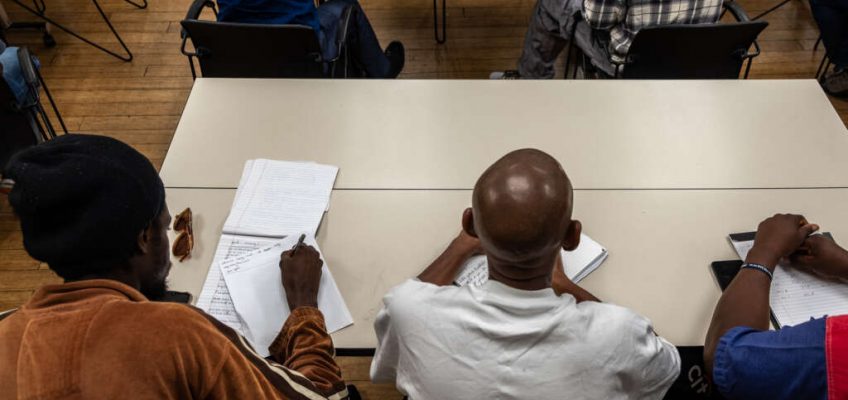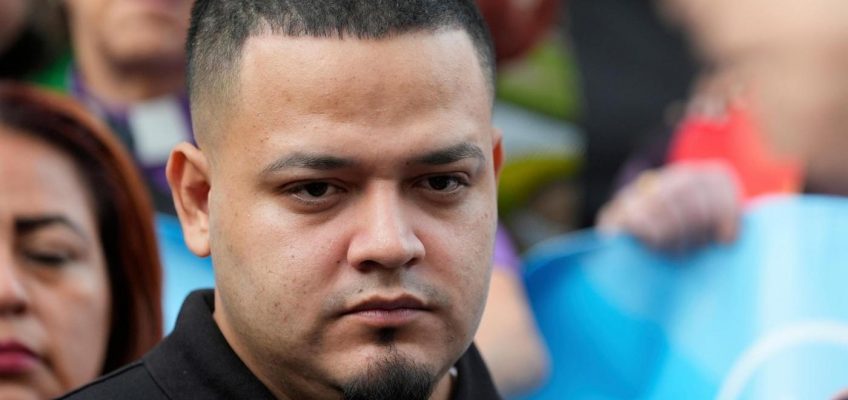En el último año fiscal, que finalizó en junio, 13.429 personas participaron en programas de alfabetización de adultos financiados por el Departamento de Juventud y Desarrollo Comunitario, lo que supone un descenso del 26 por ciento con respecto al año anterior. Sin embargo, más de 5.000 personas adicionales participaron en clases financiadas por el Concejo Municipal, que intervino para cubrir un recorte de varios millones de dólares el año pasado.
Una clase de inglés para hablantes de otros idiomas (ESOL) en St. Nicks Alliance, Brooklyn, el 5 de agosto de 2024. (Adi Talwar/City Limits)
Este artículo se publicó originalmente en inglés el 8 de octubre. Traducido por Daniel Parra. Read the English version here.
Durante años, el Departamento de Juventud y Desarrollo Comunitario (DYCD por sus siglas en inglés) de la ciudad ha colaborado con organizaciones locales para desarrollar programas de alfabetización para adultos, ayudando a los neoyorquinos a mejorar sus habilidades de lectura, escritura y comunicación para encontrar trabajo o continuar su educación.
El año pasado, el DYCD cambió la forma en que seleccionaba a los proveedores sin ánimo de lucro para los contratos de educación para adultos, y comenzó a utilizar Neighborhood Tabulation Areas (áreas de tabulación de barrios o NTA por sus siglas en inglés) para centrarse en las zonas con bajo nivel de dominio del inglés y de rendimiento educativo, y con altos índices de pobreza.
Sin embargo, tras un año del nuevo sistema de contratación, el número de personas que participaron en estos programas, que incluyen clases de inglés para inmigrantes neoyorquinos, se redujo en un 26 por ciento.
En el último año fiscal, que finalizó en junio, 13.429 personas participaron en programas de alfabetización para adultos financiados por el DYCD, lo que supone un descenso con respecto a las 18.191 del año anterior y no alcanza el objetivo previamente establecido por la agencia de 14.312.
Sin embargo, otras 5.000 personas participaron en clases financiadas por el Concejo Municipal, que intervino durante las negociaciones presupuestarias del año pasado para cubrir un recorte de $6 millones de dólares en la financiación del DYCD para programas de alfabetización de adultos en medio de la revisión del contrato.
El año pasado, los defensores criticaron rápidamente los cambios en el contrato después de que la New York City Coalition for Adult Literacy informara que más del 70 por ciento de los proveedores existentes no se encontraban en una NTA y, por lo tanto, no podían optar a la financiación.
Los fondos discrecionales del Concejo —una inyección única de $10 millones— se utilizaron para mantener a flote los programas de proveedores de larga data que quedaron fuera de los nuevos contratos, tal como informó City Limits en ese momento.
Anticipándose al impacto del recorte presupuestario, “el Concejo Municipal realizó el mayor aumento anual de la historia en la financiación discrecional para la alfabetización de adultos”, dijo Ira Yankwitt, director ejecutivo del Literacy Assistance Center (LAC por sus siglas en inglés). El LAC fue seleccionado para recopilar datos sobre las clases financiadas por el Concejo de la ciudad, y su informe de septiembre indicaba que participaron 5.290 estudiantes.
Los defensores y el personal de la oficina de la concejal Julie Won dijeron que, si se incluyen los participantes tanto en los programas financiados por el DYCD como por el Concejo, el número total de participantes se mantuvo en torno a las 18.000 personas en el último año fiscal, coincidiendo con años anteriores.
“Este número de estudiantes atendidos por el proyecto piloto nos lleva de vuelta a los más de 18.000 estudiantes atendidos en años anteriores”, dijo Farah Salam, directora de distrito de la oficina de la concejal Julie Won.
En el actual año fiscal 2026, que comenzó el 1 de julio, el Concejo volvió a asignar fondos para dos programas de educación para adultos: la Iniciativa de Alfabetización de Adultos del Concejo Municipal (su programa general de educación para adultos) y el proyecto Adult Literacy Forward del Concejo (la inversión más reciente de los legisladores en programas comunitarios, anteriormente denominado Proyecto Piloto de Alfabetización de Adultos del Concejo Municipal).
Sin embargo, ha habido otros retos a raíz de los cambios en los contratos de DYCD. La asignación y distribución de fondos llevó más tiempo del previsto, y no todas las NTA (vecindarios seleccionados por la ciudad para recibir servicios según la nueva fórmula) contaron con programas, según explicó el DYCD.
En febrero, cuando City Limits informó que dos licitadores habían retirado sus propuestas, el DYCD afirmó que había seleccionado nuevos proveedores para cubrir esas áreas. Sin embargo, al final del último año fiscal, la ciudad no había recibido ninguna propuesta viable para dos NTAs de educación básica para adultos y equivalencia de secundaria, según el DYCD.
El DYCD afirmó que la agencia está trabajando para reasignar esas plazas a programas de educación bilingüe y clases de inglés para hablantes de otros idiomas.
El nuevo método de contratación también provocó retrasos en la selección de proveedores por parte de la ciudad, lo que a su vez redujo el tiempo disponible para poner en marcha las clases.
Según el último Informe de Gestión del Alcalde (MMR por sus siglas en inglés), el porcentaje de participantes que cumplían los estándares de mejora en las habilidades lingüísticas en inglés en las clases de alfabetización de adultos también disminuyó, pasando del 59 por ciento al 54 por ciento.
“Debido a los retrasos en la adjudicación de los contratos y en el proceso de puesta en marcha del programa, los proveedores no dispusieron de tanto tiempo con los participantes para alcanzar los resultados”, explica el MMR. Algunos proveedores también tuvieron dificultades para cubrir sus plazas. El DYCD afirmó que a los proveedores que tuvieron problemas para cumplir sus objetivos este año se les ofreció la ayuda de un proveedor que podía ayudarles a mejorar su capacidad.
Una clase de conversación en inglés en la sucursal St. Agnes de la Biblioteca Pública de Nueva York en enero de 2020. (Adi Talwar/City Limits)
El DYCD afirmó que el número de plazas disminuyó porque el coste por persona aumentó para permitir una mejor programación. Sin embargo, también reconocieron que el programa tuvo un comienzo accidentado y los retrasos afectaron al número de personas inscritas.
“El DYCD se compromete a ayudar a los neoyorquinos a adquirir las habilidades de lectura, escritura y comunicación que necesitan para conseguir un trabajo, contribuir a su comunidad y continuar su educación. Nuestro Programa de Alfabetización para Adultos está haciendo precisamente eso, y estamos reforzando aún más este programa para proporcionar a los neoyorquinos las herramientas que necesitan para tener éxito”, dijo un portavoz del DYCD.
Recientemente se ha producido un aumento de la demanda de estos programas, ya que la ciudad ha acogido a más de 237.000 migrantes desde el año 2022. Alrededor de 37.000 de ellos siguen en el sistema de refugios de la ciudad.
Para ponerse en contacto con el reportero de esta noticia, escriba a Daniel@citylimits.org. Para ponerse en contacto con la editora, escriba a Jeanmarie@citylimits.org.
The post Participación en cursos de alfabetización para adultos e inglés disminuyó tras cambio en contratación appeared first on City Limits.




